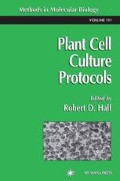Abstract
The prospect of utilizing plant tissue cultures as a means of generating and identifying novel genetic variants is one that has sparked the interest of researchers for many years. It has resulted in large numbers of research papers describing the selection and characterization of mutants, and several exhaustive reviews (e.g., 1,2), including a treatise giving detailed coverage of the whole field (3). By far the largest number of articles relate to the selection of resistant mutants, which are the most straightforward category to select in vitro, and which are the focus of the present chapter. One thing that is immediately apparent on superficially scanning the literature on these mutants is a high level of repetition. This is because the concept is simple: one challenges a large population of cells with a selective agent, and identifies “survivors” on the basis of their capacity to divide to form cell masses, or organized structures. Thus, the procedures used to select mutants resistant to a range of different antimetabolites have a certain uniformity. By the same token, selection for the same type of mutant (e.g., salt tolerant) in a range of species, involves a broadly similar strategy. On closer scrutiny of the same literature, however, it becomes apparent that far from there being a simple formula to obtain “results” for selection of every phenotype in every species, a great deal of refinement, sometimes major, sometimes subtle, has been necessary in each case. This is owing to the diversity of detail, both in the tissue-culture procedures available for each crop and in the cellular consequences of exposure to different antimetabolites.
Access this chapter
Tax calculation will be finalised at checkout
Purchases are for personal use only
References
Dix, P. J. (1986) Cell line selection, in Plant Cell Culture Technology (Yeoman, M. M, ed.), Blackwell Scientific, Oxford, pp. 143–201
Dix, P. J. (1994) Isolation and characterisation of mutant cell lines, in Plant Tissue Culture—Theory and Applications (Vasil, I. K. and Thorpe, T. A., eds.), Kluwer Academic, Dordrecht, pp. 119–138.
Dix, P. J. (ed.) (1990) Plant Cell Line Selection. VCH, Weinheim.
Negrutiu I. (1990) In vitro mutagenesis, in Plant Cell Line Selection (Dix, P. J, ed), VCH, Weinheim, pp. 19–38.
Dix, P. J. (1993) Use of chemical and physical mutagens in vitro, in Plant Tissue Culture Manual Fundamentals and Applications (Lindsey, K., ed.), Kluwer Academic, Dordrecht, Fl, pp. 1–17.
Maliga, P. (1984) Cell culture procedures for mutant selection and characterisation in Nicotiana plumbagimfoha, in Cell Culture and Somatic Cell Genetics of Plants, vol. 1, Laboratory Procedures and Their Applications (Vasil, I. K., ed.), Academic, New York, pp. 552–5562
King, P. J. (1984) Induction and maintenance of cell suspension cultures, in Cell Culture and Somatic Cell Genetics of Plants, vol. 1, Laboratory Procedures and Their applications (Vasil, I. K, ed), Academic, New York, pp 130–138
Gilissen, L. W J., Hanisch ten Cate, C. H, and Keen, B. (1983) A rapid method of determining growth characteristics of plant cell populations in batch suspension culture. Plant Cell Rep 2, 232–235.
Hagemann, R. (1982) Induction of plastome mutations by nitrosourea compounds, in Methods in Chloroplast Molecular Biology (Edelman, M., Hallick, R. B., and Chua, N H., eds), Elsevier/North Holland, Biomedical, Amsterdam, pp. 119–127
Purahauser, L., Medgyesy, P., Czako, M., Dix, P. J., and Marton, L. (1987) Stimulation of shoot regeneration in Triticum aestivum and Nicotiana plumbagimfoha Viv tissue cultures using the ethylene inhibitor AgN03. Plant Cell Rep. 6, 1–4.
Author information
Authors and Affiliations
Editor information
Editors and Affiliations
Rights and permissions
Copyright information
© 1999 Humana Press Inc., Totowa, NJ
About this protocol
Cite this protocol
Dix, P.J. (1999). Mutagenesis and the Selection of Resistant Mutants. In: Hall, R.D. (eds) Plant Cell Culture Protocols. Methods In Molecular Biology™, vol 111. Humana Press. https://doi.org/10.1385/1-59259-583-9:309
Download citation
DOI: https://doi.org/10.1385/1-59259-583-9:309
Publisher Name: Humana Press
Print ISBN: 978-0-89603-549-2
Online ISBN: 978-1-59259-583-9
eBook Packages: Springer Protocols

